13-3. Beyond the culmination
of the Head of Hercules in day 204 (July 23) and the star which
was named The End (Al Tarf,
β Gemini, *124) the 'Dead Old Sun' might have been transported back to his origin half a year away, in other
words to
recycle, to be reborn:

 |
 |
 |
 |
 |
 |
 |
 |
|
Eb3-32 |
Eb3-33 |
Eb3-34 |
Eb3-35 (104) |
Eb3-36 |
Eb3-37 |
Eb3-38 |
Eb4-1 (108) |
|
te
maitaki |
te
tagata moko |
te
henua |
te
maitaki |
tagata moko |
te
henua |
Te
maitaki |
te
henua - te
kiore |
|
Moko.
1. Lizard; moko manu uru,
figurine of a
lizard (made of wood). 2. To throw oneself on
something, to take quickly, to snatch; to flee into
the depths (of fish); tagata moko,
interloper, intruder, someone who seizes something
quickly and swiftly, or cleverly intrudes somewhere;
ka-moko ki te kai, ka-moko, ka-aaru, quickly
grab some food, grab and catch. 3. To throw oneself
upon someone, to attack: he-moko, he-reirei,
to attack and kick. 4. Moko roa: to make a
long line (of plantation); moko poto, to make
a short line. 5. Ihu moko; to die out (a
family of which remains only one male without sons);
koro hakamao te mate o te mahigo, he-toe e-tahi
tagata nó, ina aana hakaara, koîa te me'e e-kî-nei:
ku-moko-á te ihu o te mahigo. when the members
of family have died and there remains only one man
who has no offspring, we say: ku-moko-á te ihu o
te mahigo; to disappear (of a tradition, a
custom), me'e ihu moko o te tagata o te kaiga
nei, he êi, the êi is a custom no longer
in use among the people of this island. Vanaga. 1.
Lizard. P Pau., Mgv., Mq.: moko, id. Ta.
moó, id. 2. To stun, to be dizzy. PS Sa.:
mo'o, to be surprised. Hakamoko, to
accomplish. Mokohi, grain, full-grown berry (mokoi);
mokohi haraoa, grain. Mgv.: mokohe,
food. Mokoimokoi, heart T, kidney.
Mokomoko, sharp, pointed, slender, cape,
headland; gutu mokomoko, pointed lips.
Churchill. Mgv.: mokora, a duck. Ta.:
moora, id. Churchill.

... Maui
at first assumed the form of a kiore, or rat,
to enter the body of Hine. But tataeko,
the little whitehead, said he would never succeed in
that form. So he took the form of a toke, or
earth-worm. But tiwaiwaka the fantail, who
did not like worms, was against this. So Maui
turned himself into a moko huruhuru, a kind
of caterpillar that glistens. It was agreed that
this looked best, and so Maui started forth,
with comical movements. The little birds now did
their best to comply with Maui's wish. They
sat as still as they could, and held their beaks
shut tight, and tried not to laugh. But it was
impossible. It was the way Maui went in that
gave them the giggles, and in a moment little
tiwaiwaka the fantail could no longer contain
himself. He laughed out loud, with his merry, cheeky
note, and danced about with delight, his tail
flickering and his beak snapping. Hine nui
awoke with a start. She realised what was happening,
and in a moment it was all over with Maui. By
the way of rebirth he met his end ... ...
The Hawaiians also called the Milky Way Kuamoo,
Backbone of the Lizard. Many Polynesian names for
the Milky Way may be reminiscent of the crocodiles
of Western Melanesia, the moko-roa, 'long
lizards' of legend, for the same motif is found in
various parts of the Pacific. The Tuamotuans termed
the Milky Way Vaero-o-te-moko, Tail of the
Lizard, and Mango-roa, Long Shark. The
Mangaian name Moko-roa-i-ata,
Long-lizard-of-morning, not only sounds the lizard
or crocodile note but also refers to the method of
determining the small hours of the night before the
rising of the morning star. The Maori used the same
term contracted to Mokoroiata. Again they
called the Galaxy Mango-roa, Long
Shark, and Mangoroiata, Long-shark-of-dawn
...

... A une certaine saison, on
amassait des vivres, on faisait fête On emmaillotait
un corail, pierre de défunt lezard, on l'enterrait,
tanu. Cette cérémonie était un point de
départ pour beacoup d'affaires, notamment de
vacances pour le chant des tablettes ou de la
priére, tanu i te tau moko o tana pure,
enterrer la pierre sépulcrale de lézard de sa prière
... |
|
VISIBLE CLOSE TO THE FULL MOON: |
|
July 16 |
17 (*118) |
18 |
19 |
20 (*121) |
21 |
22 |
23 (204) |
|
'June
19 |
20 (*91) |
Solstice |
22 |
23 |
24 |
25 |
26 (6 * 29½) |
|
AZMIDISKE (Little Shield) =
ξ
Puppis
(117.4)
*116.0 = *117.4 - *41.4 |
Φ
Gemini
(118.4)
*117.0 = *118.4 - *41.4 |
DRUS (Hard) = χ Carinae
(119.9) |
ω Cancri (120.2) |
8h (121.7)
χ
Gemini (121.0),
NAOS (Ship) =
ζ
Puppis
(121.3) |
ρ
Puppis (122.0),
HEAP OF FUEL =
μ
Cancri
(122.1),
ζ
Monocerotis (122.3), ψ
Cancri (122.6),
REGOR (Roger backwards) =
γ
Velorum
(122.7) |
TEGMINE (The Cover) =
ζ
Cancri
(123.3) |
AL TARF (The End) =
β
Cancri
(124.3)
RAS ALGETHI (α Herculis) |
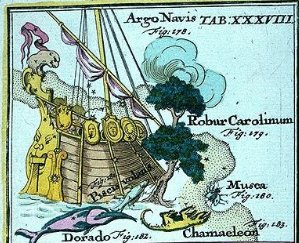 |
|
THE SUN: |
|
Jan 15 (*300) |
16 |
17 |
18 |
19 |
20 |
21 |
22 (387) |
|
'Dec 19 |
20 (*274) |
Solstice |
22 |
23 |
24 |
24 |
26 (360) |
|
Sravana-23
TYL =
ε
Draconis
(300.0),
ζ
Sagittae (300.1),
ALTAIR =
α
Aquilae
(300.3),
ο
Aquilae (300.5),
BEZEK =
η
Aquilae (Ant.)
(300.8) |
ι Sagittarii (301.2),
TEREBELLUM = ω Sagittarii,
ξ Aquilae (301.3),
ALSHAIN = β Aquilae
(301.6), φ Aquilae (301.8) |
ε
Pavonis,
θ
Sagittarii (302.3),
γ
Sagittae (302.5),
μ
Pavonis (302.7) |
τ Aquilae
(303.8) |
20h (304.4)
304.4 = 118.4 + 186.0
η Sagittae (304.2),
δ Pavonis
(304.4)
*263.0 = *77.0 + *186.0 |
SHANG WEI (Higher Guard) =
κ
Cephei
(305.2),
θ
Sagittae (305.4),
TSEEN FOO (Heavenly Raft) =
θ
Aquilae (Ant.)
(305.6), ξ Capricorni (305.8)
*264.0 = *305.4 - *41.4 |
TSO KE (Left Flag) =
ρ
Aquilae
(306.3) |
GREDI (Goat) =
α
Capricorni
(307.2),
σ
Capricorni (307.5),
ALSHAT (The Sheep) =
ν
Capricorni
(307.9) |

... In late September or early
October 130, Hadrian and his entourage, among them
Antinous, assembled at Heliopolis to set sail
upstream as part of a flotilla along the River Nile.
The retinue included officials, the Prefect, army
and naval commanders, as well as literary and
scholarly figures. Possibly also joining them was
Lucius Ceionius Commodus, a young aristocrat whom
Antinous might have deemed a rival to Hadrian's
affections. On their journey up the Nile, they
stopped at Hermopolis Magna, the primary shrine to
the god Thoth. It was shortly after this, in October
[in the year A.D.] 130 - around the time of the
festival of Osiris - that Antinous fell into the
river and died, probably from drowning. Hadrian
publicly announced his death, with gossip soon
spreading throughout the Empire that Antinous had
been intentionally killed. The nature of Antinous's
death remains a mystery to this day, and it is
possible that Hadrian himself never knew; however,
various hypotheses have been put forward.
One possibility is that he was
murdered by a conspiracy at court. However, Lambert
asserted that this was unlikely because it lacked
any supporting historical evidence, and because
Antinous himself seemingly exerted little influence
over Hadrian, thus meaning that an assassination
served little purpose. Another suggestion is that
Antinous had died during a voluntary castration as
part of an attempt to retain his youth and thus his
sexual appeal to Hadrian. However, this is
improbable because Hadrian deemed both castration
and circumcision to be abominations and as Antinous
was aged between 18 and 20 at the time of death, any
such operation would have been ineffective. A third
possibility is that the death was accidental,
perhaps if Antinous was intoxicated. However, in the
surviving evidence Hadrian
does not describe the death as being an accident;
Lambert thought that this was suspicious. Another
possibility is that Antinous represented a voluntary
human sacrifice. Our earliest surviving evidence for
this comes from the writings of Dio Cassius, 80
years after the event, although it would later be
repeated in many subsequent sources. In the second
century Roman Empire, a belief that the death of one
could rejuvenate the health of another was
widespread, and Hadrian had been ill for many years;
in this scenario, Antinous could have sacrificed
himself in the belief that Hadrian would have
recovered. Alternately, in Egyptian tradition it was
held that sacrifices of boys to the Nile,
particularly at the time of the October Osiris
festival, would ensure that the River would flood to
its full capacity and thus fertilize the valley;
this was made all the more urgent as the Nile's
floods had been insufficient for full agricultural
production in both 129 and 130. In this situation,
Hadrian might not have revealed the cause of
Antinous's death because he did not wish to appear
either physically or politically weak. Conversely,
opposing this possibility is the fact that Hadrian
disliked human sacrifice and had strengthened laws
against it in the Empire ... |
The Cover star, Tegmine, ζ Cancri, was at *107 + *16
= *123 (→ number of signs on
the top side of the Phaistos disc).

But down on earth time would push on
as before:
 |
 |
 |
 |
 |
|
Eb4-2 |
Eb4-3 |
Eb4-4 (111) |
Eb4-5 |
Eb4-6 |
|
te vero |
te henua |
toko tokoga |
te henua - e rima |
te kiore - te henua |
|
Vero.
To throw, to hurl (a lance, a spear).
This word was also used with the particle kua
preposed: koía kua vero i te matá, he is
the one who threw the obsidian [weapon].
Verovero, to throw, to hurl repeatedly,
quickly (iterative of vero). Vanaga. 1.
Arrow, dart, harpoon, lance, spear, nail, to
lacerate, to transpierce (veo). P Mgv.:
vero, to dart, to throw a lance, the
tail; verovero, ray, beam, tentacle. Mq.:
veó, dart, lance, harpoon, tail, horn.
Ta.: vero, dart, lance. 2. To turn over
face down. 3. Ta.: verovero, to twinkle
like the stars. Ha.: welowelo, the light
of a firebrand thrown into the air. 4. Mq.:
veo, tenth month of the lunar year. Ha.:
welo, a month (about April). Churchill. Sa.:
velo, to cast a spear or dart, to spear.
To.: velo, to dart. Fu.: velo,
velosi, to lance. Uvea: velo, to
cast; impulse, incitement. Niuē:
velo,
to throw a spear or dart. Ma.: wero,
to stab, to pierce, to spear. Ta.:
vero, to dart
or throw a spear. Mg.: vero,
to pierce, to lance. Mgv.: vero,
to lance, to throw a spear. Mq.: veo,
to lance, to throw a spear. Churchill 2.
... The
strongest and most expert of the warriors is
chosen to receive him on his landing. The
warrior watches the canoe along the beach; and
as soon as the king lands, and has thrown off
his cloak, he darts his spear at him, from a
distance of about thirty paces, and the king
must either catch the spear in his hand, or
suffer from it: there is no jesting in the
business. Having caught it, he carries it under
his arm, with the sharp end downwards, into the
temple or heavoo. On his entrance, the
assembled multitude begin their sham-fights, and
immediately the air is obscured by clouds of
spears, made for the occasion with blunted ends.
Hamamea (the king) has been frequently
advised to abolish this ridiculous ceremony, in
which he risks his life every year; but to no
effect. His answer always is, that he is as able
to catch a spear as any one on the island is to
throw it at him. During the Macahity, all
punishments are remitted throughout the country;
and no person can leave the place in which he
commences these holidays, let the affair be ever
so important ...
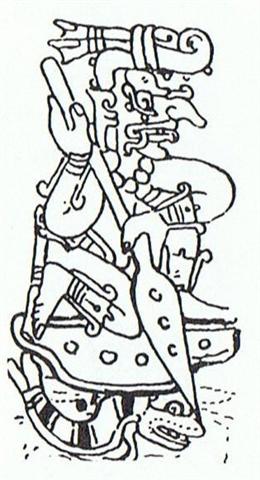
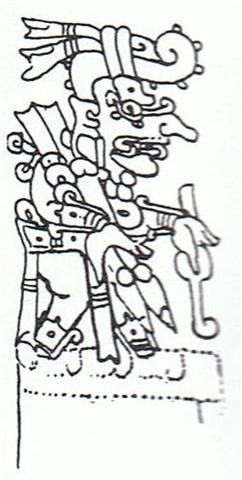 |
|
VISIBLE CLOSE
TO THE FULL MOON: |
|
July 24
(*125) |
25 |
26 |
27 (2 * 104) |
28 |
|
'June 27 |
28 |
29 (*100) |
30 (181) →
SIRIUS |
31 |
|
"June 13
(*84) |
14 |
15 |
16 |
17 (168) |
|
MAY 21 (*61) |
22 |
23 |
24 (12 * 12) |
25 (145) |
|
χ
Cancri (125.2),
BRIGHT FIRE =
λ
Cancri (125.4)
*84.0 = *125.4 - *41.4 |
AVIOR =
ε
Carinae (126.4),
φ
Cancri (126.8)
*85.0 = *126.4 - *41.4 |
Ο Ursae Majoris (127.4)
*86.0 = *127.4 - *41.4 |
Pushya-8
(Nourisher)
υ Cancri (128.1), θ
Cancri (128.2) |
Āshleshā-9 (Embrace)
/
Willow-24 (Stag)
π¹
Ursa Majoris,
δ
HYDRAE (129.6),
AL MINHAR AL SHUJĀ
=
σ
Hydrae, MUSEIDA =
π²
Ursae Majoris
(129.9)
RAS ALHAGUE (α Ophiuchi) |
 |
|
THE SUN: |
|
'Dec 27 |
28 |
29 (*310 -
*27) |
30 (364) |
31 (*285) |
|
Al Sa’d al Dhabih-20 (Lucky One of the
Slaughterers)
/
Ox / Heard Boy
(Buffalo)
DABIH =
β
Capricorni
(308.0),
κ
Sagittarii (308.1),
SADIR (Hen's Breast) =
γ
Cygni (308.4),
PEACOCK =
α
Pavonis
(308.7)
*267.0 = *308.4 - *41.4 |
KHUFU
OKUL =
π
Capricorni
(309.6),
BOS =
ρ
Capricorni
(309.9)
ARNEB (α
Leporis)
MINTAKA (δ Orionis) |
KHAFRE
ο
Capricorni (310.2),
θ
Cephei (310.5)
HEKA (λ Orionis)
ALNILAM (ε
Orionis) |
MENKAURE
ROTTEN MELON =
ε
Delphini,
φ
Pavonis (311.2),
η
Delphini (311.4),
ζ
Delphini,
ρ
Pavonis (311.7)
PHAKT (α
Columbae)
ALNILAK (ζ Orionis)
*270.0 = *311.4 - *41.4 |
ROTANEV = β Delphini,
ι Delphini (312.3), τ Capricorni (312.6), κ
Delphini (312.7),
SVALOCIN = α Delphini,
υ Capricorni, υ Pavonis (312.8) |
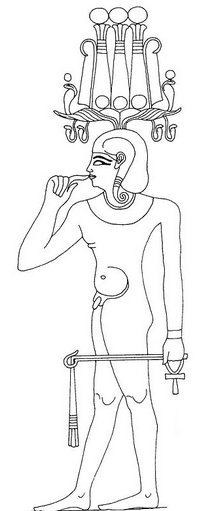 |
Julius Caesar had determined that the Great Creator (Khnum)
- personified by the Egyptian primary god-pharaoh Khufu -
should have his culmination night at the place half a year
away from 'June 28, where he would lead the triplet ending
in day 181 + 183 when Sirius was at the Full Moon.

This great triplet of pyramids were located on
the western bank of the Nile
(the River of Life) and thus this triplet had to indicate a burial
site, because the place of birth was in the east. The
location of this final station corresponded to 'June 26 + half a
year = 354 / 2 + 366 / 2 = 177 + 183 = 360 = 'December 26.
... The Celtic year was divided into two halves with the
second half beginning in July, apparently after a seven-day
wake, or funeral feast, in the oak-king's honour ...
From Sirius (*101) to Thuban (*212) there were
*111 days, and anciently this star had announced spring equinox when
observed close to the right ascension line of the Full Moon. 110 +
1 = 111.
... About Carmenta we know from the
historian Dionysus Periergetis that she gave orcales to
Hercules and lived to the age of 110 years ....
|
April 17 (107) |
18
(156 - 48 = 108) |
19 |
20 |
21 |
 |
 |
 |
 |
 |
|
Ea5-19 |
Ea5-20 (108 + 48) |
Ea5-21 (157 → 314 / 2) |
Ea5-22 |
Ea5-23 |
|
te henua |
kua moe |
inoino |
koia ra kua moe |
ki te inoino |
|
Al Sharatain-1
/
Ashvini-1 /
Bond-16 (Dog)
/
Mahrū-sha-rishu-ku-1 (Front of
the Head of Ku)
SEGIN =
ε
Cassiopeia, MESARTHIM =
γ
Arietis,
ψ
Phoenicis (27.2),
SHERATAN (Pair of Signs) =
β
Arietis,
φ
Phoenicis (27.4)
*351.0 = *27.4 - *41.4 |
ι Arietis (28.0), λ Arietis (28.2), υ Ceti (28.8) |
ALRISHA (The Knot) = α Piscium,
χ Phoenicis (29.2),
ε
Trianguli (29.4),
ALAMAK
(Caracal) = γ Andromedae
(29.7)
*353.0 = *29.4 - *41.4 |
Arku-sha-rishu-ku-2 (Back of the Head of Ku)
2h (*30.4 = *354.0 + *41.4)
κ
Arietis (30.3),
HAMAL (Sheep) = α Arietis
(30.5)
ALKES (α
Crateris) |
DELTOTUM = β Trianguli
(31.2), ι Trianguli (31.7), η Arietis (31.9) |
 |
|
Oct 16 |
17 |
18 |
19 (292) |
20 |
|
No star listed (209) |
MUPHRID (Solitary Star) = η Bootis
(210.1), ζ Centauri (210.3) |
φ Centauri (211.0), υ¹ Centauri (211.1), υ² Centauri
(211.8), τ Virginis (211.9) |
AGENA (At the Knee) =
β
Centauri
(212.1),
θ
Apodis (212.5),
THUBAN (Dragon) =
α
Draconis
(212.8) |
14h (213.1)
π Hydrae, χ
Centauri (213.0),
MENKENT (Shoulder of the Centaur) =
θ
Centauri
(213.1) |
Later the star at the north pole had shifted to the opposite
side of the year, to Polaris,
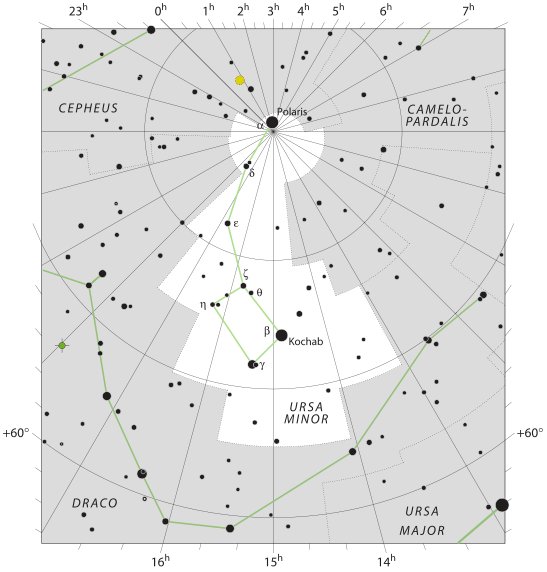
and therefore the northern spring equinox instead had to be
ruled at the Ram rising with the Sun.
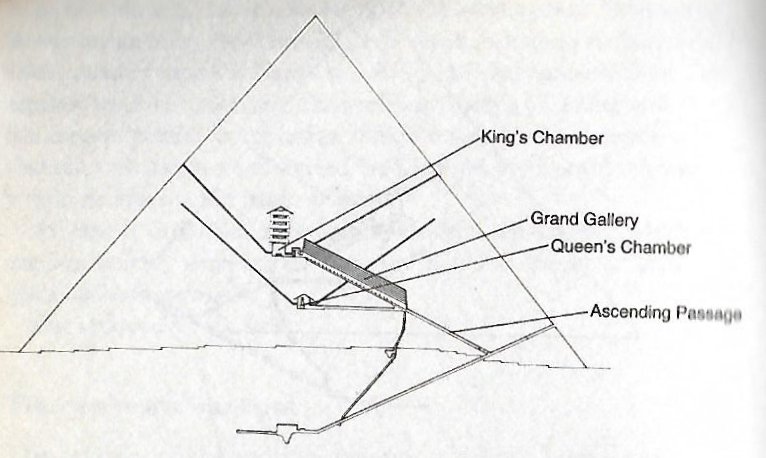
... Thuban
could be seen, both by day and night, from the bottom of the
central passage of the Great Pyramid of Cheops (Knum
Khufu) at Ghizeh, in 30° of north latitude, as also from
the similar points in five other like structures; and the
same fact is asserted by Sir John Herschel as to the two
pyramids at Abousseir ... For some
reason, too, it had taken their fancy to place the Great
Pyramid almost exactly on the 30th parallel at latitude 29º
58' 51". This, a former astronomer royal of Scotland once
observed, was 'a sensible defalcation from 30º', but not
necessarily in error: For if the original designer had
wished that men should see with their body, rather than
their mental eyes, the pole of the sky from the foot of the
Great Pyramid, at an altitude before them of 30º, he would
have had to take account of the refraction of the
atmosphere, and that would have necessitated the building
standing not at 30º but at 29º 58' 22' ...
When Thuban culminated it was in the night
when the Sun reached Rigel.
Metoro said this was the place from where to count (hia):
... In view of the almost universal
prevalence of the Pleiades year throughout the Polynesian
area it is surprising to find that in the South Island and
certain parts of the North Island of New Zealand and in the
neighboring Chatham Islands, the year began with the new
Moon after the yearly morning rising, not of the Pleiades,
but of the star Rigel [*78] in Orion ...
|
Dec 1 |
2 (336 = 2 * 118) |
3 (329 + 8) |
4 |
5 |
6 (340) |
 |
 |
 |
 |
 |
 |
|
Ea1-18 → 4 * 29½ |
Ea1-19 |
Ea1-20 |
Ea1-21 → 11 * 11 |
Ea1-22 |
Ea1-23 |
|
ki te marama |
koia ra - kua oho ki toona o te
marama |
e agaagata era e |
ka oho koe - ki roto o te hare
pure |
kua huki - koia |
kua huki - ku Rei ku huki
hia mai |
|
Aga. Work; to work, to make,
to build, to create: O te atua i-aga-ai i te
ragi, i te henua. God made heaven and earth.
Vanaga. Agahuru (hagahuru, hagauru).
Agai (hagai). Agatahi (aga-tahi)
one, (hagatahi); agatahi ahi atu, day
before yesterday; hagatahi ahi, yesterday.
Churchill.
Rei.
1. To tread, to trample on: rei kiraro
ki te va'e. 2. (Used figuratively) away with
you! ka-rei kiraro koe, e mageo ê, go away,
you disgusting man. 3. To shed tears: he rei i te
mata vai. 4. Crescent-shaped breast ornament,
necklace; reimiro, wooden, crescent-shaped
breast ornament; rei matapuku, necklace made
of coral or of mother-of-pearl; rei pipipipi,
necklace made of shells; rei pureva, necklace
made of stones. 5. Clavicle. Îka reirei,
vanquished enemy, who is kicked (rei).
Vanaga. T. 1. Neck. 2. Figure-head.
Rei mua =
Figure-head in the bow.
Rei muri = Figure-head in the stern.
Henry. Mother of pearl;
rei kauaha,
fin. Mgv.: rei,
whale's tooth. Mq.:
éi, id. This is probably associable with
the general Polynesian
rei, which
means the tooth of the cachalot, an object held in
such esteem that in Viti one tooth (tambua)
was the ransom of a man's life, the ransom of a soul
on the spirit path that led through the perils of Na
Kauvandra to the last abode in Mbulotu. The word is
undoubtedly descriptive, generic as to some
character which Polynesian perception sees shared by
whale ivory and nacre.
Rei kauaha
is not this rei;
in the Maori
whakarei designates the carved work at
bow and stern of the canoe and Tahiti has the same
use but without particularizing the carving:
assuming a sense descriptive of something which
projects in a relatively thin and flat form from the
main body, and this describes these canoe ornaments,
it will be seen that it might be applied to the fins
of fishes, which in these waters are frequently
ornamental in hue and shape. The latter sense is
confined to the Tongafiti migration. Reirei,
to trample down, to knead, to pound. Pau.:
Rei-hopehopega, nape. Churchill. |
|
π¹
Orionis (73.0),
ο²
Orionis (73.4),
HASSALEH =
ι
Aurigae
(73.6),
π6
Orionis (73.9)
*32.0 = *73.4 - *41.4 |
ALMAAZ (The Male Goat) =
ε
Aurigae
(74.7),
HAEDUS I =
ζ
Aurigae
(74.8) |
HAEDUS II = η Aurigae
(75.9) |
5h (*76.1)
ε
Leporis (76.0),
CURSA (Footstool) =
β
Eridani (76.4),
λ Eridani (76.7)
*35.0 = *76.4 - *41.4 |
μ Aurigae, μ Leporis (77.6 |
ĸ Leporis (78.0),
RIGEL (Foot) =
β
Orionis
(78.1),
Flaming Star = IC405
(78.2),
CAPELLA (Mother Goat) =
α
Aurigae (78.4),
ο
Columbae,
τ
Orionis (78.8)
*37.0 = *78.4 - *41.4
THUBAN (α Draconis) |
 |
|
MARCH 30 |
31 (90) |
APRIL 1 |
2 |
3 |
4 |

|


























